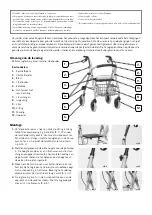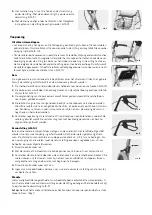
Please read these notes carefully before use. Be sure to follow the instructions and keep them in a safe place!
If this aid is to be used by other persons, they must be fully informed of these safety warnings before use.
User Instructions
Rollator aluminium
Item No. 11447 000
GB
Indication/Contraindication
The rollator is a mobility aid for people with mobility restrictions, e. g. people with a disability that makes walking
difficult or who cannot walk for long, providing them with the opportunity to go further afield.
Staying on the move with a rollator not only serves to improve circulation, coordination and balance, but it also
enhances the user’s well-being.
This rollator is designed both for use in enclosed areas and in the open. It is equipped with a removable basket and a tray.
The rollator provides a seat and back rest for short rests. It can be folded easily for transportation, thus saving space. The
rollator should not be used by persons with perception impairments, serious problems with their balance or an inability to
sit. The user must have adequate perception skills and adequate physical ability to be able to steer a rollator.
Safety Indications
• Talk to your doctor or specialist retailer to see whether this Rollator
isoptimally suitable for you and your needs.
• Only use the rollator if it is in perfect condition and the folding lock is in
position. Check the following points before the start of each trip:
– all the screws are tight
– the surfaces of the wheels are intact
– the locking levers are tightened up
– the folding lock has correctly snapped into place
– the brakes are working properly (the parking brake
and the driving brake)
– the frame and the welded seams show no visible signs of wear
– are the wheels and wheel forks clean and can the wheels easily be turned
• Ensure that the Rollator is correctly engaged before every use.
• This rollator should only be used on firm flat ground. It should never be
used as an aid to getting up out of a seat or a crouching position or for
transporting people.
• Do not move the rollator when someone is sitting on the seat. It may
not be used outside its intended use or to transport objects weighing
more than 15 kg or persons.
• The stability of the rollator can be greatly reduced on inclined surfaces
or if it is overloaded. If possible, only use flat routes.
• On smooth surfaces such as tiles, stone flooring, PVC, etc. the wheels can
block when braking under certain circumstances. Therefore please check
the braking performance of your Rollator carefully on these floors and
adjust the way you move and walk accordingly. If you wish to sit on the
Rollator you should also make sure that the wheels have a sufficient hold
on the surface when the brakes are applied and that the Rollator cannot
slide away.
• The wheels can get wedged in grids, cracks and uneven surfaces. Avoid
all obstacles wherever possible.
• There is a risk of slipping on dirty, frosty or snow-covered ground,
where the brake action is limited. Always be aware of these hazards
when using the rollator.
• Ensure that the handles are adjusted to the correct height for the user in
order to avoid improper weight load or falls. We recommend you walk-
between the handles. Always hold both handles; otherwise you can lose
your balance.
• Make sure that your hands or clothes do not come into contact with
themoving parts of the Rollator! Be particularly careful when folding and
unfolding the Rollator. This applies in particular to hinges under the seat
or in the middle of the cross brace.
• The Rollator should be used on the pavement. The Rollator should not be
used in moving traffic. For your personal safety on the roads it is recom-
mended that you also wear your own reflectors as well as those fixed to
the Rollator.
• Be careful near children. Children should not play with the Rollator!
• The brakes should always be used slowly, evenly and on both sides.
When »parking« the rollator always lock the brakes to prevent it from
rolling away.
• The brake action can deteriorate with the wear of the tyres, so check the
brakes regularly.
• The maximum carrying capacity of the walker is 120 kg. This includes the
maximum load in the basket of 15 kg.
• Always sit on the seat vertically, never at a slant! Do not lean over the
side or backwards of the walker.
• Do not hang any bags or baskets on the handles or on the security screw.
Otherwise the balance of the rollator may be adversely affected.
• Do not carry out any adjustments or modifications, which impair the
safety of the design. Parts such as wheels, handles or brake cables may
only be replaced by a specialist retailer. Only use accessories approved
by the manufacturer.
• Do not carry or pull the Rollator by the brake cables.
• In strong sunlight parts of the rollator, e.g. the handles and seat, can get
hot. Please ensure that you cover your rollator up or leave it in a shady
place.
• Please prevent skin contact with the walker if the walker has been in cold
temperature for a long period of time in order to prevent freezing.
• Keep the rollator away from naked flames.
• Please prevent running into door frames, furniture, etc. with the walker
and check the secure position of the walker when parked. The frame,
connection elements and welding seams may be damaged if the walker
tips over.
• Please also prevent placing stress on the walker when folded together!
This could damage the frame, connection elements and welding seams.
• Do not use the walker in stairs or escalators.
• Do not stand on the rollator.
• Do not lean on the brake lever.
• If you have any queries, please refer to your dealer.




















